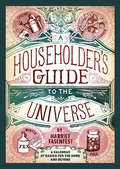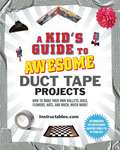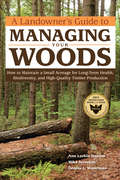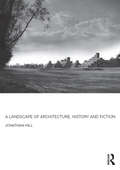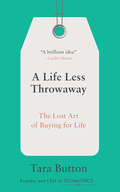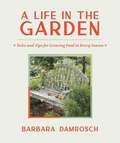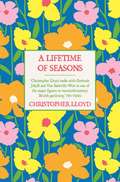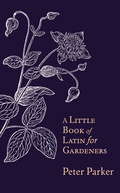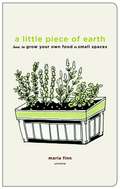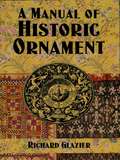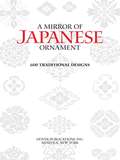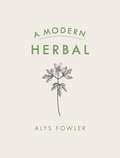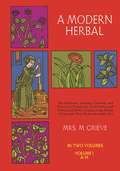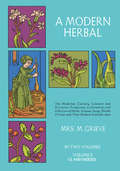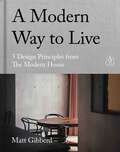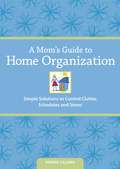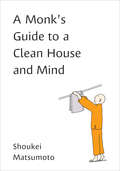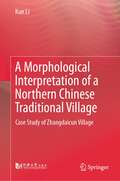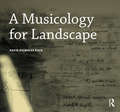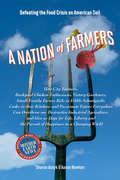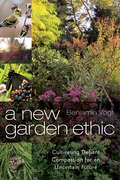- Table View
- List View
A Householder's Guide to the Universe
by Harriet FasenfestNowadays, "go local," "organic food," and "sustainability" are on the tip of everyone's tongue. Harriet Fasenfest's A Householder's Guide to the Universe takes up the banner of progressive homemaking and urban farming as a way to confront the political, social, and environmental issues facing the world. While offering plenty of useful advice on how to do common household chores sustainably, Fasenfest goes deeper to discuss the philosophy of "householding." The book is organized in monthly installments according to season, and the author invites readers into her own home, garden, and kitchen to consider concrete tools for change. Streetwise and poetic, fierce and romantic, the book is more than just a blueprint for escaping the current economic and environmental logjam - it's also a readable and pithy analysis of how we got there.
A Householder's Guide to the Universe: A Calendar of Basics for the Home and Beyond
by Harriet FasenfestIn an era when go local, organic food, and sustainability are one the tip of everyone's tongues, Harriet Fasenfest's A Householder's Guide to the Universe takes up the banner of progressive homemaking and urban farming as a way to confront the political, social, and environmental issues facing our world today. In an era when go local, organic food, and sustainability are on the tip of everyone's tongues, Harriet Fasenfest's A Householder's Guide to the Universe takes up the banner of progressive homemaking and urban farming as a way to confront the political, social, and environmental issues facing our world today. Offering grass-roots practical advice on how to shop, garden, run a household, preserve and cook food, and more, Fasenfest also discusses the philosophy of householding. In A Householder's Guide to the Universe, which is organized according to season and presented in monthly installments, Fasenfest invites the reader into her home, garden, and kitchen to consider concrete tools for change. Streetwise and poetic, fierce and romantic, the book provides not only a way out of our current economic and environmental logjam but also a readable and often funny analysis of how we got there.
A Householder's Guide to the Universe: A Calendar of Basics for the Home and Beyond
by Harriet FasenfestIn an era when go local, organic food, and sustainability are one the tip of everyone's tongues, Harriet Fasenfest's A Householder's Guide to the Universe takes up the banner of progressive homemaking and urban farming as a way to confront the political, social, and environmental issues facing our world today. In an era when go local, organic food, and sustainability are on the tip of everyone's tongues, Harriet Fasenfest's A Householder's Guide to the Universe takes up the banner of progressive homemaking and urban farming as a way to confront the political, social, and environmental issues facing our world today. Offering grass-roots practical advice on how to shop, garden, run a household, preserve and cook food, and more, Fasenfest also discusses the philosophy of householding. In A Householder's Guide to the Universe, which is organized according to season and presented in monthly installments, Fasenfest invites the reader into her home, garden, and kitchen to consider concrete tools for change. Streetwise and poetic, fierce and romantic, the book provides not only a way out of our current economic and environmental logjam but also a readable and often funny analysis of how we got there.
A Householder's Guide to the Universe: A Calendar of Basics for the Home and Beyond
by Harriet FasenfestIn an era when go local, organic food, and sustainability are one the tip of everyone's tongues, Harriet Fasenfest's A Householder's Guide to the Universe takes up the banner of progressive homemaking and urban farming as a way to confront the political, social, and environmental issues facing our world today. In an era when go local, organic food, and sustainability are on the tip of everyone's tongues, Harriet Fasenfest's A Householder's Guide to the Universe takes up the banner of progressive homemaking and urban farming as a way to confront the political, social, and environmental issues facing our world today. Offering grass-roots practical advice on how to shop, garden, run a household, preserve and cook food, and more, Fasenfest also discusses the philosophy of householding. In A Householder's Guide to the Universe, which is organized according to season and presented in monthly installments, Fasenfest invites the reader into her home, garden, and kitchen to consider concrete tools for change. Streetwise and poetic, fierce and romantic, the book provides not only a way out of our current economic and environmental logjam but also a readable and often funny analysis of how we got there.
A Kid's Guide to Awesome Duct Tape Projects: How to Make Your Own Wallets, Bags, Flowers, Hats, and Much, Much More!
by Instructables. Com Nicole SmithIt is a known fact of the universe that duct tape can fix anything. If it's broken, just add duct tape! For generations this has been the case, and now thanks to Instructables.com, there's one more thing duct tape can fix-boredom!<P><P>Duct tape has come a long way since being a simple metallic roll that you'd find in your grandparent's basement. Walk into any craft or DIY store and you'll have your senses bombarded with all sorts of colors and patterns, like argyle, zebra print, and even penguins! And unlike fancy origami paper or glitter, duct tape is inexpensive and lasts forever.Only in this all-in-one Instructables collection can you find some of the most unique duct tape projects that will make you the coolest person you know. Everybody will be talking about your duct tape art, with projects including:The classic duct tape walletA dapper duct tape bow tieA fabulous duct tape clutchDuct tape lilies for your valentineAnd so many more!Making paper snowflakes and beaded bracelets are so twentieth century; the future is here and it's made from duct tape. Impress your friends, entertain guests, keep your creative juices flowing, and save tons of money on Christmas presents all at the same time! With A Kid's Guide to Awesome Duct Tape Projects, you'll be the talk of the town before you even know it.
A Landowner's Guide to Managing Your Woods: How to Maintain a Small Acreage for Long-Term Health, Biodiversity, and High-Quality Timber Production
by Anne Larkin Hansen Mike Severson Dennis L. WatermanWhether you have a few acres of trees in the suburbs or a small commercial forest, you can encourage a healthy and sustainable ecosystem through proper woodland management. This introductory guide shows you how to identify the type, health, and quality of your trees and suggests strategies for keeping your woodland thriving.
A Landscape of Architecture, History and Fiction
by Jonathan HillArchitecture can be analogous to a history, a fiction, and a landscape. We expect a history or a novel to be written in words, but they can also be cast in concrete or seeded in soil. The catalyst to this tradition was the simultaneous and interdependent emergence in the eighteenth century of new art forms: the picturesque landscape, the analytical history, and the English novel. Each of them instigated a creative and questioning response to empiricism’s detailed investigation of subjective experience and the natural world, and together they stimulated a design practice and lyrical environmentalism that profoundly influenced subsequent centuries. Associating the changing natural world with journeys in self-understanding, and the design process with a visual and spatial autobiography, this book describes journeys between London and the North Sea in successive centuries, analysing an enduring and evolving tradition from the picturesque and romanticism to modernism. Creative architects have often looked to the past to understand the present and imagine the future. Twenty-first-century architects need to appreciate the shock of the old as well as the shock of the new.
A Life Less Throwaway: The Lost Art of Buying for Life
by Tara ButtonA revolutionary guide to the art of mindful buying that will teach you how to resist cheaply made goods and make smart, fulfilling purchases that last a lifetime. With the whole world trying to convince us to spend our way to happiness, we’ve been left cluttered, stressed, and unfulfilled. Tara Button, founder of BuyMeOnce, is at the forefront of the global movement to change the way we shop and live forever. Tara advocates a life of mindful buying that celebrates what lasts, giving you exercises that help you curb impulses, ignore trends, and discover your true style. Once a shopaholic herself, her groundbreaking mindful curation method reveals the amazing benefits of buying for life and will help you: • Spot the tricks that make you overspend • De-clutter your home • Find the products that serve you best • Rediscover the art of keeping and caring for things • Find happiness, success, and self-worth, beyond buying
A Life in the Garden: Tales and Tips for Growing Food in Every Season
by Barbara DamroschOne of America's most well-known and bestselling gardening writers shares her reflections and advice on finding joy in the garden In A Life in the Garden, horticultural icon Barbara Damrosch imparts a lifetime of wisdom on growing food for herself and her family. In writing that's accessible, engaging, and elegant, she welcomes us to garden alongside her. Personal, thoughtful, and often humorous, this book offers practical DIY insights that will delight gardeners, cooks, and small-scale farmers. With a personal and sometimes irreverent tone, Barbara expresses the pleasure she takes in gardening, the sense of empowerment she finds in it, and the importance of a partnership with the real expert: nature.
A Lifetime of Seasons: The Best of Christopher Lloyd
by Christopher Lloyd'He was the best informed, liveliest and most innovative gardening writer of our times' GUARDIAN'Infuriating, irascible ... a brilliant gardener and a brilliant writer' Monty Don, ObserverChristo Lloyd was recognised as one of the foremost gardeners and garden writers of the 20th century. Here, for the first time, is the definitive collection of his best, most informative, and so often amusing, garden writing.Christo on gardening: Ours, in its humble way, is an art as well as a craft. At the same time it keeps us in touch with the earth, the seasons, and with that complex of interrelated forces both animate and inanimate which we call nature. It is a humanizing occupation.On weeding:Many gardeners will agree that hand-weeding is not the terrible drudgery that it is often made out to be. Some people find in it a kind of soothing monotony. It leaves their minds free to develop the plot for their next novel or to perfect the brilliant repartee with which they should have encountered a relative's latest example of unreasonableness.
A Little Book of Latin for Gardeners
by Peter ParkerHow did the delphinium get its name? Which parts of the body lend their names to auriculas and orchids? Who are the gentian, lobelia and heuchera named after? Why are nasturtiums and antirrhinums connected? What does an everlasting pea have to do with Indian miniature paintings?These are some of the questions answered in Peter Parker's adventurous exploration of the mysteries of Botanical Latin.Evolved over many centuries and often thought to belong to the rarefied world of scholars and scientists, this invented language is in fact a very useful tool for everyday gardening. It allows us to find our way around nurseries; it sorts out confusions when two plants have the same English name; and it gives us all kinds of information about how big or small a plant will grow, what shape or colour it will develop, and what habitat it prefers.In his lively survey, Parker agues that Botanical Latin is not merely useful, but fun. The naming of plants draws upon geography, social and medical history, folklore, mythology, language, literature, the human body, the animal kingdom and all manner of ancient beliefs and superstitions.The book, beautifully illustrated with old woodcuts, explains how and why plants have been named, includes handy lists of identifying adjectives, and takes the reader down some of the stranger byways of human endeavour and eccentricity.
A Little Piece of Earth: How to Grow Your Own Food in Small Spaces
by Maria FinnA hip, eco-friendly guide with fun and easy projects for all levels. Eating locally has so many benefits--for the planet, for your health, and for your taste buds--and you can't get much more local than your very own backyard. But is planting a garden too big a commitment? Then this book is for you. A Little Piece of Earth is all about starting small, with more than fifty self-contained, doable projects. Whether you have a yard, a terrace, a rooftop, or just a windowsill, there are plenty of ideas and inspirations to choose from. Harvest your own precious vanilla pods from a pot indoors. Grow savory shiitakes on a small log in your kitchen. Build a miniature vineyard trellis on your deck or build a raised bed on your patio. Recipes for using your homegrown bounty are sprinkled throughout. Charming illustrations guide you through step-by-step, and there's a complete resources section. This is about making dirt work for you, taking some control over your food supply, and, most important, enriching your life with the quiet, simple pleasures of produce raised organically with your own hands.
A Manual of Historic Ornament
by Richard GlazierExceptionally comprehensive, easy-to-use guide surveys the evolution of historic ornament in architecture and the applied arts — from primitive ornaments of Oceania, Egypt, and Assyria to a Gothic doorway in Amiens, the tomb of Lorenzo de Medici, and a classic early-19th-century sofa by Thomas Hope. Over 700 black-and-white illustrations. 16 plates of photographs.
A Mirror of Japanese Ornament: 600 Traditional Designs
by DoverRendered from a rare 1915 five-volume set, this all-encompassing design treasury captures the graceful beauty of traditional Japanese motifs. These 100 full-color plates--many with multiple images--range from ornate florals and elegant cranes to dragons and Buddhas, and from Silk Road imports to Edo-style textile patterns.A veritable grammar of Japanese ornament, this compilation includes an Introduction, Chronology, and Bibliography, as well as captions translated from the original Japanese notes. In addition to their applications for fabric and wallpaper designs, these vivid royalty-free images are ideal for a tremendous variety of graphics projects, and are, in addition, a treat for connoisseurs of Japanese art.
A Modern Herbal
by Alys FowlerTHE BEST GARDENING BOOKS OF THE YEAR - GARDENS ILLUSTRATED'Informative and enthusiastic' i PaperPLANT-BASED MEDICINE FOR A CALMER, HEALTHIER LIFE It's easy to turn to the pharmacy when we're stressed, sick or feeling under the weather, but what if you turned to your garden instead?In this accessible and easy to use manual, horticultural expert, former Gardener's World presenter and Guardian columnist, Alys Fowler, shows how to take control of your health by adopting a more natural lifestyle. For thousands of years, people who had no access to clinical medicine knew how to boost their well-being by using the ingredients they found in plants. Herbs are the people's medicine; often freely available and abundant, they are ready and waiting to be plucked from around you to soothe and heal your body and mind. With guides for how to use and grow over 100 herbs - for example how to use fennel for indigestion, camomile for anxiety and nettle for hayfever - you'll soon be heading into the garden, rather than opening the medicine cabinet. Offering a fusion of botanical, practical, cultural and historical information, A Modern Herbal reveals how common herbs are the simple, cleansing way to better health and happiness.AS SEEN IN THE GUARDIAN'An important and accessible herbal for the 21st century . . . For anyone delving into herbs for the first time or those who want to broaden their herbal repertoire in the garden and home, this book is much needed' Gardens Illustrated
A Modern Herbal
by Margaret GrieveIf you want to know how pleurisy root, lungwort, and abscess root got their names, how poison ivy used to treat rheumatism, or how garlic guarded against the Bubonic Plague, consult A Modern Herbal. This 20th-century version of the medieval Herbal is as rich in scientific fact and folklore as its predecessors and is equally encyclopedic in coverage. From aconite to zedoary, not an herb, grass, fungus, shrub or tree is overlooked; and strange and wonderful discoveries about even the most common of plants await the reader.Traditionally, an herbal combined the folk beliefs and tales about plants, the medicinal properties (and parts used) of the herbs, and their botanical classification. But Mrs. Grieve has extended and enlarged the tradition; her coverage of asafetida, bearberry, broom, chamomile, chickweed, dandelion, dock, elecampane, almond, eyebright, fenugreek, moss, fern, figwort, gentian, Hart's tongue, indigo, acacia, jaborandi, kava kava, lavender, pimpernel, rhubarb, squill, sage, thyme, sarsaparilla, unicorn root, valerian, woundwort, yew, etc. — more than 800 varieties in all — includes in addition methods of cultivation; the chemical constituents, dosages, and preparations of extracts and tinctures, unknown to earlier herbalists; possible economic and cosmetic properties, and detailed illustrations, from root to bud, of 161 plants.Of the many exceptional plants covered in Herbal, perhaps the most fascinating are the poisonous varieties — hemlock, poison oak, aconite, etc. — whose poisons, in certain cases, serve medical purposes and whose antidotes (if known) are given in detail. And of the many unique features, perhaps the most interesting are the hundreds of recipes and instructions for making ointments, lotions, sauces, wines, and fruit brandies like bilberry and carrot jam, elderberry and mint vinegar, sagina sauce, and cucumber lotion for sunburn; and the hundreds of prescriptions for tonics and liniments for bronchitis, arthritis, dropsy, jaundice, nervous tension, skin disease, and other ailments. 96 plates, 161 illustrations.
A Modern Herbal: Vol. II
by Margaret GrieveIf you want to know how pleurisy root, lungwort, and abscess root got their names, how poison ivy used to treat rheumatism, or how garlic guarded against the Bubonic Plague, consult A Modern Herbal. This 20th-century version of the medieval Herbal is as rich in scientific fact and folklore as its predecessors and is equally encyclopedic in coverage. From aconite to zedoary, not an herb, grass, fungus, shrub or tree is overlooked; and strange and wonderful discoveries about even the most common of plants await the reader.Traditionally, an herbal combined the folk beliefs and tales about plants, the medicinal properties (and parts used) of the herbs, and their botanical classification. But Mrs. Grieve has extended and enlarged the tradition; her coverage of asafetida, bearberry, broom, chamomile, chickweed, dandelion, dock, elecampane, almond, eyebright, fenugreek, moss, fern, figwort, gentian, Hart's tongue, indigo, acacia, jaborandi, kava kava, lavender, pimpernel, rhubarb, squill, sage, thyme, sarsaparilla, unicorn root, valerian, woundwort, yew, etc. — more than 800 varieties in all — includes in addition methods of cultivation; the chemical constituents, dosages, and preparations of extracts and tinctures, unknown to earlier herbalists; possible economic and cosmetic properties, and detailed illustrations, from root to bud, of 161 plants.Of the many exceptional plants covered in Herbal, perhaps the most fascinating are the poisonous varieties — hemlock, poison oak, aconite, etc. — whose poisons, in certain cases, serve medical purposes and whose antidotes (if known) are given in detail. And of the many unique features, perhaps the most interesting are the hundreds of recipes and instructions for making ointments, lotions, sauces, wines, and fruit brandies like bilberry and carrot jam, elderberry and mint vinegar, sagina sauce, and cucumber lotion for sunburn; and the hundreds of prescriptions for tonics and liniments for bronchitis, arthritis, dropsy, jaundice, nervous tension, skin disease, and other ailments. 96 plates, 161 illustrations.
A Modern Way to Live: 5 Design Principles from The Modern House
by Matt GibberdBeautifully designed and featuring breathtaking photography, this book from the creator of The Modern House makes the perfect coffee table book and is the ultimate gift for home design enthusiasts 'A source of fascination, inspiration and fantasy' GuardianIn 2005, childhood friends Matt Gibberd and Albert Hill set out to convince people of the power of good design and its ability to influence our wellbeing. They founded The Modern House - in equal parts an estate agency, a publisher and a lifestyle brand - and went on to inspire a generation to live more thoughtfully and beautifully at home.As The Modern House grew, Matt and Albert came to realise that the most successful homes they encountered - from cleverly conceived studio flats to listed architectural masterpieces - had been designed with attention to the same timeless principles: Space, Light, Materials, Nature and Decoration.In this lavishly illustrated book, Matt tells the stories of these remarkable living spaces and their equally remarkable owners, and demonstrates how the five principles can be applied to your own space in ways both large and small. Revolutionary in its simplicity, and full of elegance, humour and joy, this book will inspire you to find happiness in the place you call home.PRAISE FOR THE MODERN HOUSE:'One of the best things in the world' GQ'The Modern House transformed our search for the perfect home' Financial Times'Nowhere has mastered the art of showing off the most desirable homes for both buyers and casual browsers alike than The Modern House' Vogue
A Mom's Guide to Home Organization
by Debbie LillardCreate a Happy, Clutter-Free Home! Do you dream of having a clutter-free kitchen, organized closet, tidy toy room and stress-free schedule? All of this and more is within your reach when you follow the practical and effective organizing advice in this book. In this ultimate home organization guide Debbie Lillard, professional organizer and mother of three, helps you gain and maintain order in three key areas of your family life: Your Time: Learn how to get more done in less time by streamlining everyday duties, creating morning, after-school and bedtime routines, and effectively managing extracurricular activities. Your Belongings: Use Debbie's simple but effective C.P.R. method (Categorize, Purge, and Rearrange) to organize, toys, clothes, children's artwork, paperwork, photos, collections and more. Your Home: Follow the step-by-step instructions for organizing every room in your home, plus find help for keeping your child's schoolbag, desk, locker, and home study area organized. Follow the book from start to finish for a complete home makeover, or dip in here or there for help with one problem area at a time. The tried-and-true advice will help you simplify your life so you can spend less time struggling to keep up and more time savoring everyday moments with your family.
A Mom's Guide to Home Organization
by Debbie LillardCreate a Happy, Clutter-Free Home! Do you dream of having a clutter-free kitchen, organized closet, tidy toy room and stress-free schedule? All of this and more is within your reach when you follow the practical and effective organizing advice in this book. In this ultimate home organization guide Debbie Lillard, professional organizer and mother of three, helps you gain and maintain order in three key areas of your family life: Your Time: Learn how to get more done in less time by streamlining everyday duties, creating morning, after-school and bedtime routines, and effectively managing extracurricular activities. Your Belongings: Use Debbie's simple but effective C.P.R. method (Categorize, Purge, and Rearrange) to organize, toys, clothes, children's artwork, paperwork, photos, collections and more. Your Home: Follow the step-by-step instructions for organizing every room in your home, plus find help for keeping your child's schoolbag, desk, locker, and home study area organized. Follow the book from start to finish for a complete home makeover, or dip in here or there for help with one problem area at a time. The tried-and-true advice will help you simplify your life so you can spend less time struggling to keep up and more time savoring everyday moments with your family.
A Monk's Guide to a Clean House and Mind: Housekeeping Secrets From The World's Tidiest Monks
by Shoukei MatsumotoLittle known fact: Buddhist Monks are amazing at cleaning and tidying. In this one-of-a-kind guide to cleaning your home, Buddhist monk Shoukei Matsumoto reveals how to make your home as spotless as it is tranquil and peaceful. For Buddhist monks cleaning well is a cardinal skill and, in A Monk's Guide to a Clean House and Mind, readers will discover their never-before-shared cleaning pro tips. In the Zen Buddhist tradition, true enlightenment is impossible if your home has even a speck of dust and, as such, Buddhist monks have much to teach us lay people about achieving a truly Zen clean. A Monk's Guide to a Clean House and Mind features charming illustrations and step-by-step instructions on such essential household cleansing tips as: * First, Air It Out: Before cleaning anything Monk's first open the temple windows to purify the air and let the crisp morning breeze in. * Don't Procrastinate: 'Zengosaidan ' is a Zen expression meaning that one should put all their efforts into each day so they have no regrets. In the context of cleaning, this means don't put off cleaning those dishes you've left in the sink. * Remember to Put On Your Samue: Samue robes are worn by Japanese monks when they perform their daily duties of cleaning and looking after the temple. Easy to move in and to wash and care for, they are the perfect cleaning attire.From cleaning up everything from your kitchen sink, toilet, and that pile of unidentified stuff in the corner of your garage to your mind, body, and spirit, this book will guide you in creating a home environment that will calm your thoughts and nourish your soul.
A Morphological Interpretation of a Northern Chinese Traditional Village: Case Study of Zhangdaicun Village
by Kun LiThis book challenges the definition of a new approach for integrating protection and enhancing the Chinese heritage category of “Traditional Villages”. By applying a specific case study in the Hancheng context, Shaanxi Province, which lacks sound studies, the book formulates new theoretical prerequisites for future re-searches, an in-depth knowledge path, and sound methodological principles. By working in a multiple scales approach, the object of preservation and enhancement is first of all redefined in its ontology as a unity formed by the courtyard type, the morphology of the village, and the related landscape structures. All these three levels of study have been deeply investigated, put into the relationship and resulting in a new methodology which overcomes the inadequacy and ineffectiveness of the notion of “setting” deriving from conservation Charters, to embrace the structural notion of “context” and a knowledge approach to rural settlements’ form. The innovative and original features of this book are both in the reading villages in their landscape dimension, which in turn is studied as a context made of several interrelated structures. Another original feature of the book is the integration of Italian historic-structural and morphological methodologies with specific Chinese cultural aspects. The author’s work dug deeply and interdisciplinary in all those dimensions to account for the complex issues that are related and embodied in both the physical and intangible meaning of human settlements, opening a novel scientific methodology for Chinese studies as a sound base to define three key integrated project actions: what, why, how to preserve, enhance, develop.
A Musicology for Landscape (Design Research in Architecture)
by David Nicholas BuckDrawing conceptually and directly on music notation, this book investigates landscape architecture’s inherent temporality. It argues that the rich history of notating time in music provides a critical model for this under-researched and under-theorised aspect of landscape architecture, while also ennobling sound in the sensory appreciation of landscape. A Musicology for Landscape makes available to a wider landscape architecture and urban design audience the works of three influential composers – Morton Feldman, György Ligeti and Michael Finnissy – presenting a critical evaluation of their work within music, as well as a means in which it might be used in design research. Each of the musical scores is juxtaposed with design representations by Kevin Appleyard, Bernard Tschumi and William Kent, before the author examines four landscape spaces through the development of new landscape architectural notations. In doing so, this work offers valuable insights into the methods used by landscape architects for the benefit of musicians, and by bringing together musical composition and landscape architecture through notation, it affords a focused and sensitive exploration of temporality and sound in both fields.
A Nation of Farmers
by Sharon Astyk Aaron Newton"Astyk and Newton have written an important book with an unusual message: We need millions of new farmers...as soon as possible. You could not find two more reasonable, intelligent, sincere, and passionate people to talk to about food. And the book has very much the feeling of a conversation - with someone smart who cares about you. It is also intellectually complex, creative and nuanced. The authors are big thinkers and have taken a good lick at the central human issues of our time." Peter Bane "This definitive guide can provide inspiration to gardeners and those concerned about the environment. It offers practical solutions to all the food-related problems brought on by industrialized agriculture and the globalization of food. Very carefully researched and well written, this documents what is wrong and what we can do about it." Connie Krochmal - Bellaonline "This outstanding and well-written compendium of insights and recommendations, of fervent idealism and practical solutions, is highly recommended."--Library Journal Once we could fill our grocery carts with cheap and plentiful food, but not anymore. Cheap food has gone the way of cheap oil. Climate change is already reducing crop yields worldwide. The cost of flying in food from far away and shipping it across the country in refrigerated trucks is rapidly becoming unviable. Cars and cows increasingly devour grain harvests, sending prices skyrocketing. More Americans than ever before require food stamps and food pantries just to get by, and a worldwide food crisis is unfolding, overseas and in our kitchens. We can keep hunger from stalking our families, but doing so will require a fundamental shift in our approach to field and table. A Nation of Farmers examines the limits and dangers of the globalized food system and shows how returning to the basics is our best hope. The book includes in-depth guidelines for: Creating resilient local food systems Growing, cooking, and eating sustainably and naturally Becoming part of the solution to the food crisis The book argues that we need to make self-provisioning, once the most ordinary of human activities, central to our lives. The results will be better food, better health, better security, and freedom from corporations that don't have our interests at heart. This is critical reading for anyone who eats and cares about high-quality food. Sharon Astyk farms in New York, and is the author of Depletion and Abundance. Aaron Newton is a sustainable systems land planner in North Carolina, and is the founding editor of Groovy Green.
A New Garden Ethic: Cultivating Defiant Compassion for an Uncertain Future
by Benjamin VogtIn a time of climate change and mass extinction, how we garden matters more than ever: “An outstanding and deeply passionate book.” —Marc Bekoff, author of The Emotional Lives of AnimalsPlenty of books tell home gardeners and professional landscape designers how to garden sustainably, what plants to use, and what resources to explore. Yet few examine why our urban wildlife gardens matter so much—not just for ourselves, but for the larger human and animal communities.Our landscapes push aside wildlife and in turn diminish our genetically programmed love for wildness. How can we get ourselves back into balance through gardens, to speak life's language and learn from other species?Benjamin Vogt addresses why we need a new garden ethic, and why we urgently need wildness in our daily lives—lives sequestered in buildings surrounded by monocultures of lawn and concrete that significantly harm our physical and mental health. He examines the psychological issues around climate change and mass extinction as a way to understand how we are short-circuiting our response to global crises, especially by not growing native plants in our gardens. Simply put, environmentalism is not political; it's social justice for all species marginalized today and for those facing extinction tomorrow. By thinking deeply and honestly about our built landscapes, we can create a compassionate activism that connects us more profoundly to nature and to one another.
